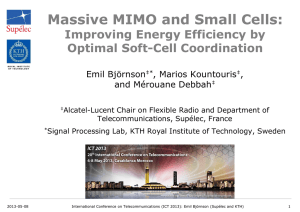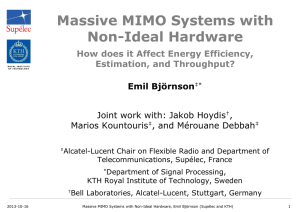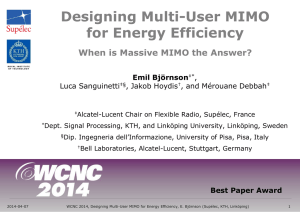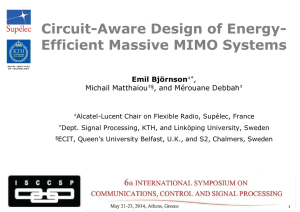Presentation - Communication Systems division
advertisement
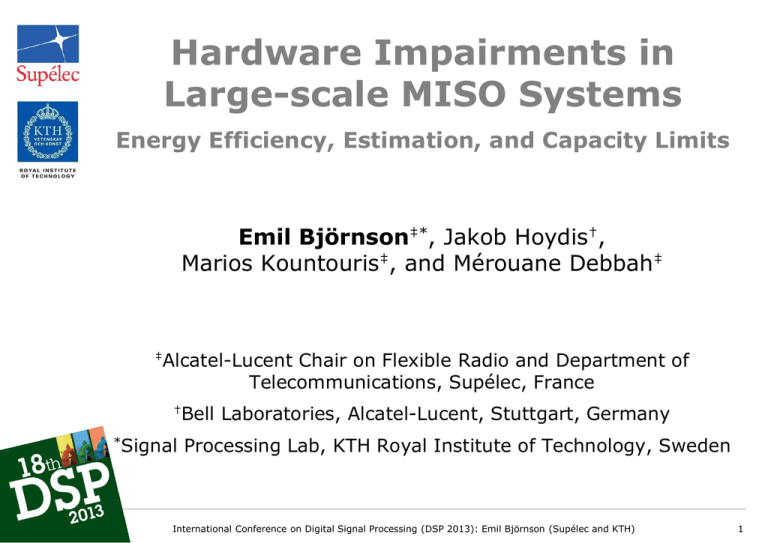
Hardware Impairments in Large-scale MISO Systems Energy Efficiency, Estimation, and Capacity Limits Emil Björnson‡*, Jakob Hoydis†, Marios Kountouris‡, and Mérouane Debbah‡ ‡Alcatel-Lucent Chair on Flexible Radio and Department of Telecommunications, Supélec, France †Bell *Signal 2013-06-01 Laboratories, Alcatel-Lucent, Stuttgart, Germany Processing Lab, KTH Royal Institute of Technology, Sweden International Conference on Digital Signal Processing (DSP 2013): Emil Björnson (Supélec and KTH) 1 Introduction 2013-06-01 International Conference on Digital Signal Processing (DSP 2013): Emil Björnson (Supélec and KTH) 2 Challenge of Network Traffic Growth • Data Dominant Era - 66% annual traffic growth - Exponential increase! • Is this Growth Sustainable? - User demand will increase - Increased traffic supply only if network revenue is sustained! Source: Cisco Visual Networking Index • Continuous Network Evolution - What will be the next step? 2013-06-01 International Conference on Digital Signal Processing (DSP 2013): Emil Björnson (Supélec and KTH) 3 What Will Be Next Steps? • More Frequency Spectrum - Scarcity in conventional bands: Use mmWave, cognitive radio - Joint optimization of current networks (Wifi, 2G/3G/4G) Our Focus: • Improved Spectral Efficiency - More antennas/km2 (space division multiple access) • What Limits the Spectral Efficiency? - 2013-06-01 Propagation losses and transmit power Channel capacity Channel estimation accuracy (inter-user interference) Signal processing complexity International Conference on Digital Signal Processing (DSP 2013): Emil Björnson (Supélec and KTH) 4 New Paradigm: Large Antenna Arrays • Remarkable New Network Architecture - Deploy large arrays at macro base stations • Everything Seems to Become Better [1] - Large array gain (improves channel conditions) Higher capacity (more antennas more users) Orthogonal channels (little inter-user interference) Linear processing optimal (low complexity) • Properties Proved by Asymptotic Analysis - Are conventional models applicable? [1] F. Rusek, D. Persson, B. Lau, E. Larsson, T. Marzetta, O. Edfors, F. Tufvesson, “Scaling up MIMO: Opportunities and challenges with very large arrays,” IEEE Signal Process. Mag., 2013. 2013-06-01 International Conference on Digital Signal Processing (DSP 2013): Emil Björnson (Supélec and KTH) 5 Transceiver Hardware Impairments • Physical Hardware is Non-Ideal - Oscillator phase noise - Amplifier non-linearity - IQ imbalance in mixers, etc. • Impact of Hardware Impairments - Mismatch between the intended and emitted signal - Distortion of received signal - Limits capacity in high-SNR regime [2] What happens in many-antennas regime? Will everything still get better? [2]: E. Björnson, P. Zetterberg, M. Bengtsson, B. Ottersten, “Capacity Limits and Multiplexing Gains of MIMO Channels with Transceiver Impairments,” IEEE Communications Letters, 2013 2013-06-01 International Conference on Digital Signal Processing (DSP 2013): Emil Björnson (Supélec and KTH) 6 Channel Model with Hardware Impairments 2013-06-01 International Conference on Digital Signal Processing (DSP 2013): Emil Björnson (Supélec and KTH) 7 Our Focus: Point-to-Point Channel • Scenario - Base station (BS): 𝑁 antennas User terminal (UT): 1 antenna Channel vector Rayleigh fading • Time-Division Duplex (TDD) - 2013-06-01 Channel reciprocity Uplink estimation of h Downlink beamforming: User only needs to estimate h𝐻 w International Conference on Digital Signal Processing (DSP 2013): Emil Björnson (Supélec and KTH) 8 Generalized Channel Model • Received Downlink Signal Data Signal: Transmitter Distortion Uplink: Analogous generalizatio n Noise: Receiver Distortion Distortion Noise per Antenna Proportional to transmitted/received signal power 4 Prop. Constants: BS or UT, transmit or receive [3]: T. Schenk, RF Imperfections in High-Rate Wireless Systems: Impact and Digital Compensation. Springer, 2008 2013-06-01 International Conference on Digital Signal Processing (DSP 2013): Emil Björnson (Supélec and KTH) 9 Interpretation of Distortion Model • Gaussian Distortion Noise - Independent between antennas - Depends on beamforming - Still uncorrelated directivity Little in the signal dimension • Error Vector Magnitude (EVM) - Quality of transceivers: - LTE requirements: 0≤EVM≤0.17 (smaller higher rates) - Distortion will not vanish at high SNR! 2013-06-01 International Conference on Digital Signal Processing (DSP 2013): Emil Björnson (Supélec and KTH) 10 Main Contribution 2013-06-01 International Conference on Digital Signal Processing (DSP 2013): Emil Björnson (Supélec and KTH) 11 Contribution 1: Channel Estimation • New Linear MMSE Estimator - Distortion noise is correlated with channel - Normalized MSE is independent of 𝑁 New Insights Low SNR: Small difference High SNR: Error floor Error floor for i.i.d. channels: Characterized by impairments! Very different MSE but no need to change estimator 2013-06-01 International Conference on Digital Signal Processing (DSP 2013): Emil Björnson (Supélec and KTH) 12 Contribution 2: Capacity Limits • Explicit Capacity Bounds - Upper: Channel is known - Lower: LMMSE estimator - Asymptotic limits: New Insights Capacity limited by UT hardware 𝑁 → ∞: No impact of BS! Large gain with moderate arrays Quick convergence in 𝑁 Upper/lower limits almost same 2013-06-01 International Conference on Digital Signal Processing (DSP 2013): Emil Björnson (Supélec and KTH) 13 Contribution 3: Energy Efficiency • Energy Efficiency in bits/Joule Capacity [bits/channel use] Power [Joule/channel use] - Capacity limited as 𝑁 → ∞ - EE = Theorem Reduce power as 1 , 𝑁𝑡 𝑡< 1 2 Non-zero capacity as 𝑁 → ∞ New Insights Power reduction from array gain Same as with ideal hardware! Capacity lower bounded by EE grows without bound! 2013-06-01 International Conference on Digital Signal Processing (DSP 2013): Emil Björnson (Supélec and KTH) 14 Conclusions & Outlook 2013-06-01 International Conference on Digital Signal Processing (DSP 2013): Emil Björnson (Supélec and KTH) 15 Conclusions • New Paradigm: Large Antenna Arrays at BSs - Promise high asymptotic spectral and energy efficiency • Physical Hardware has Impairments - Creates distortion noise: Limits signal quality - Limits estimation accuracy and prevents high capacity - High energy efficiency is still possible! • Some Encouraging Results [4] - Reduce BS hardware quality as 𝑁 - SDMA is possible: Inter-cell interference drowns in distortions [4] E. Björnson, J. Hoydis, M. Kountouris, M. Debbah, “Massive MIMO Systems with Non-Ideal Hardware: Energy Efficiency, Estimation, and Capacity Limits,” Trans. Information Theory, submitted arXiv:1307.2584 2013-06-01 International Conference on Digital Signal Processing (DSP 2013): Emil Björnson (Supélec and KTH) 16 Thank You for Listening! Questions? All Papers Available: http://flexible-radio.com/emil-bjornson 2013-06-01 International Conference on Digital Signal Processing (DSP 2013): Emil Björnson (Supélec and KTH) 17
